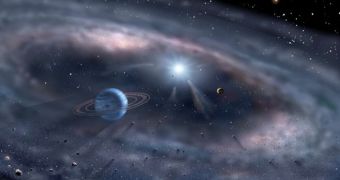Using the enormous resolve power of the twin W. M. Keck Observatory telescopes, in Hawaii, astronomers have been able for the first time to look inside the protoplanetary disk around a newly formed star. The observations have the ability to significantly increase our knowledge of how planets are formed, and how they evolve in their orbits. Their interactions, and the mechanisms at work to determine the final orbital configurations of the star systems could also be unlocked following such observations, Space Fellowship reports.
“When it comes to building rocky planets like our own, the innermost part of the disk is where the action is,” William Danchi, a member of the team that carried out the new study, explains. He is based at the NASA Goddard Space Flight Center, in Greenbelt, Maryland. The reason why the inner protoplanetary disk is so crucial for our understanding of exoplanetary formation is the fact that bodies formed there may be dead square inside the stars' habitable zones, just like the Earth is. Scientists could therefore get a chance to observe the phenomena shaping the possibilities of life forming on these rocks in real time.
This is important because new studies show that almost everything about the Earth is extraterrestrial. A large amount of its minerals, as well as the basic chemicals making up the water and the atmosphere appear to have come from comets, during the early stages of our planet's development. The new study was only made possible by using the twin ten-meter telescopes at the Keck Observatory. The two structures are separated by a distance of 85 meters, and they function on interferometry, which means that they behave as a single, massive mirror, capable of making out very small details.
“Nothing else in the world provides us with the types of measurements the Keck Interferometer does. In effect, it’s a zoom lens for the Keck telescopes,” Jet Propulsion Laboratory (JPL) expert Wesley Traub explains. The JPL is located at the California Institute of Technology (Caltech), in Pasadena. The target of the observations was the blue, B-type star Young Stellar Object (YSO) known as MWC 419, which was seen for the first time in August 2008. The object lies about 2,100 light-years away in the constellation Cassiopeia, and is believed to be less than one million years old.
It was observed in the L band, which features wavelengths from 3.5 to 4.1 micrometers. “This unique infrared capability adds a new dimension to the Keck Interferometer in probing the density and temperature of planet-forming regions around YSO disks. This wavelength region is relatively unexplored. Basically, anything we see through this camera is brand new information,” KO expert Sam Ragland says. The star was also determined to lie about 50 million miles away from its parent star. “That’s about half of Earth’s distance from the sun, and well within the orbit of Venus,” Danchi says.

 14 DAY TRIAL //
14 DAY TRIAL //